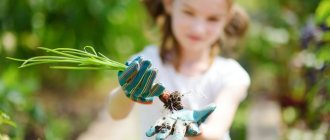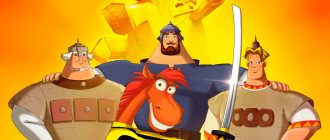Amazing teeth
How are teeth arranged and why are they needed? Teeth are the hardest parts of our body. Newborn children have no teeth. Only by the age of 2-3 years the child’s first 20 teeth grow. They are called milk teeth because after 6 years they are replaced by permanent ones: 16 on the upper jaw and 16 on the lower jaw. If a person loses a permanent tooth, a new one will never grow.
There are different types of teeth: canines, incisors, molars and all teeth perform their functions: incisors - bite off, cut food, molars chew, and canines help to gnaw solid food. Humans need teeth for biting, crushing and chewing food. Healthy teeth decorate the face, and we also use them when we pronounce many sounds (for example, “d”, “z”, “l”, “s”, “t”). Therefore, it is very important to take care of your teeth and treat them on time.
A tooth is a living organ that consists of three main parts - crown, neck, root. The crown is the part of the tooth that is visible in the mouth. The roots go into the gum and firmly anchor the tooth in the jaw. The neck is the part of the tooth that is located between the crown and the root. It is covered by the gum.
Any tooth is covered with a thin layer of enamel, which is the main protector of the tooth. Enamel is made of calcium. Beneath the enamel is dentin, a substance similar to bone but harder. Beneath the layer of enamel and dentin is the core of the tooth - the pulp - soft tissue that contains nerves and blood vessels. Thanks to nerves, the tooth senses heat and cold. Through blood vessels, oxygen, nutrients, and vitamins necessary for the growth and preservation of the tooth enter the tooth.
The part that we do not see is located in the gum and is called the root. It secures the teeth so that they do not become loose or fall out. A nerve passes through the root. The outside of the tooth root is covered with a special protective substance - cement. The base of the tooth is supported by the gum - a mucous membrane, a very dense and thick shell, equipped with blood vessels and nerves.
Progress of the experiment:
The teacher suggested learning how to brush your teeth correctly in order to remove leftover food between the teeth. Pieces of cotton wool got stuck between the teeth of the comb, almost like food between our teeth. I'll run the toothbrush along the teeth, now from the base to the tips.
When is it best to remove excess?
When we brush from the base to the tips. First we brush the front teeth: from bottom to top, from top to bottom, both outside and inside; then the side ones - on the left side, the side ones - on the right side.
Conclusion: It is good to clean all the spaces between your teeth with a toothbrush; after such brushing, your teeth are not afraid of germs. You need to brush your teeth 2 times a day - morning and evening for 3 minutes and rinse your mouth after each meal.
Experience “How tooth enamel is destroyed”
Purpose: to show how tooth enamel is destroyed when exposed to acid, which is formed when chewing food.
Materials: water, 2 glasses, 2 eggs, acetic acid, spoon.
What causes diseases of teeth and gums?
Finding out the causes of diseases of teeth and gums, I studied the literature and learned a lot of useful information. It turns out that one of the most common causes of dental disease is poor oral hygiene . After eating, food remains on the surface of the tooth or between the teeth. It sticks to the gum, gradually turning into “dental plaque.”
Dental plaque is a sticky thin film located on the surface of the tooth and containing a huge amount of bacteria. This process occurs especially intensely when eating sweet, soft, sticky and viscous foods. Over time - 18-28 hours - the plaque becomes hard, bacteria multiply on it, and when sugar re-enters, acid is formed , which destroys tooth enamel. The acid destroys the enamel, penetrates the dentin and reaches the pulp. The nerve reacts to this, and the tooth begins to hurt. This is how caries begins.
The process of formation of hard plaque lasts on average 20 hours, so by removing plaque from the surface of the tooth 2 times a day - once every 12 hours, you can significantly reduce the likelihood of caries. Nowadays, you can take care of your oral cavity in different ways: using toothpaste and a brush, toothpick, dental floss, using rinses and chewing gum.
Experiment No. 1 “The effect of acid on tooth enamel”
Our teeth can also be damaged by mechanical damage to the enamel and temperature changes . Teeth are given to a person for chewing food, and not for opening bottles, cracking nuts, or biting objects not intended for food, such as pencils and pens. Many children from our class chew pens, pencils, and nails. All this leads to cracks in tooth enamel and can lead to caries. Teeth can also deteriorate if, for example, you drink cold juice, water, or eat ice cream immediately after a hot meal. The enamel cannot withstand such sudden temperature changes and cracks, leaving the tooth without protection.
Experiment No. 2 “Negative effects of temperature changes on teeth”
Research project "Neboleyka's Tooth"
Bibliographic description:
Kobeleva, E. M. Research project “Neboleyka’s Tooth” / E. M. Kobeleva, R. M. Yakushcheva. — Text: direct // Questions of preschool pedagogy. — 2021. — No. 1 (7). — P. 40-42. — URL: https://moluch.ru/th/1/archive/49/1638/ (access date: 12/19/2021).
If you want to live long, keep your teeth healthy. Teeth are an indicator of health. It is necessary to take care of the oral cavity from birth. Early and proper care of children's teeth is the basis for healthy teeth for life. The correct formation of the jaw bones depends on the presence of all primary (but healthy) teeth. Their early removal (or loss) leads to the development of malocclusion, which affects the formation of correct sound pronunciation.
Parents are truly happy only when their child is healthy and cheerful. He smiles at the world around him, and I want to believe that it will always be like this. Among other concerns about maintaining the baby’s health, we should never forget about the health of teeth and gums.
Nature has rewarded us with two “generations” of teeth - milk, or temporary, and permanent. Surprisingly, most parents are not very worried when a child loses baby teeth due to caries. All the same, they believe, new ones will grow. This common misconception has dire consequences. It is the baby teeth that create the “foundation” for the permanent teeth. If a child loses his baby teeth prematurely due to caries, the proper growth and development of the jaws and permanent teeth is disrupted. In addition, the buds of permanent teeth are located directly under the baby teeth, and infection can easily penetrate into the jaw and destroy them. In this case, the teeth grow crooked and underdeveloped, or they may even die. And therefore, it is necessary to introduce the rules and methods of dental care already in preschool age.
From 3 to 6 years of age, all baby teeth erupt and a temporary bite is formed.
A child will not be able to properly clean his teeth until he is 6–7 years old on his own, because his motor skills are imperfect due to the immaturity of the nervous system. It is impossible to speed up this process. Until school age, the child only trains, and brushing the child’s teeth is carried out by the parents.
One of the tasks of preschool educational institutions in the work to create a healthy lifestyle is to, together with parents, form in children habits that preserve and strengthen health from childhood: maintaining a daily routine, proper nutrition, expanding knowledge about methods and means of oral care, hardening, formation of the need for movement.
The older the child, the more confident his skills become. By the age of 7, a child brushes his teeth himself competently.
This project promotes the formation of a conscious attitude towards one’s health and expands knowledge about methods and means of oral care. The experiments carried out made it possible to expand the knowledge that dyes contained in drinks such as Fanta and Pepsi-Cola stain and destroy tooth enamel......
As a result of working on the project, the children of our group demonstrated the ability to analyze, express their thoughts convincingly and draw their own conclusions.
"Neboleyka's Tooth."
Problem: Children do not have enough experience in dental care and dental care products.
Relevance of the project: the developed skill of proper oral care, instilled from childhood, remains for the rest of life.
Project goal: To form in preschool children a conscious attitude towards their health through search and cognitive activity.
Tasks:
- Develop the idea that health is the main value of human life; form the habit of a healthy lifestyle.
- Provide knowledge about methods and means of oral care, reinforce the rules and skills of dental care.
- Develop a conscious attitude towards your health.
Project type
− according to the number of participants - collective;
− according to the priority of the method - research;
− according to the contingent – same age;
− in terms of duration - long-term.
Participants - children, teachers, parents.
Step-by-step solution to the project: “Neboleyka’s tooth.”
Stage 1 . Supporting children's cognitive initiative, leading children to their own conclusions. (collection of information)
− viewing encyclopedias;
− watching videos;
− survey of kindergarten employees.
Stage 2. Practical activities of children aimed at obtaining results.
− familiarization with the rules of dental care;
− consolidate the ability to brush your teeth;
− quiz “How to keep your teeth healthy”;
− collection of folk wisdom (together with parents).
Problematic situation.
The girl Dasha has a toothache, how to cure the tooth and what needs to be done to prevent her teeth from hurting?
Stage 3. Product of project activity.
− creation of the “Book of Wisdom from Neboleyka’s tooth.”
Stage 4. Project presentation.
Literature:
- Aleksandrova E. Yu. Health-improving work in preschool educational institutions under the “Island of Health” program. Volgograd: Teacher, 2007. – 151 p.
- Kiseleva L. S. Project method in the activities of a preschool institution: a manual for managers and practical workers of preschool educational institutions. M.: ARKTI, 2003. - 96 p.
- Krylova N.I. Health-saving space in a preschool educational institution. Design, trainings, classes. Volgograd: Teacher 2009. – 218 p.
- Prokhorova L.N. Organization of experimental activities of preschoolers: methodological recommendations. M.: ARKTI, 2004. – 64 p.
- Sidorchuk T. A., Korzun A. V. Imagining, reflecting, creating...: a manual for teachers and heads of institutions providing preschool education. M., LLC Publishing House "White Wind", 2006. - 201 p.
- Tsepennikova V.I. Miracles that are nearby. Perm, 1992. - 93 p.
- Shatalova S.P. My first encyclopedia. M., “Onyx”, 2000. - 15 p.
Key terms
(automatically generated)
: tooth, oral cavity, conscious attitude, child, care product, healthy lifestyle, health, dairy, parent.
A little history about teeth
It turns out that since ancient times people have tried to take care of their teeth. One of the most ancient hygiene products are toothpicks. Archaeologists claim that Neanderthals used toothpicks. They used twigs, pointed sticks to remove pieces of remaining food from the surface of the tooth.
Even before our era, toothpicks began to be made of gold and silver. Few people could afford toothpicks made of precious metals, so they were made from feathers, ivory and wood. For example, in Mexico they were made from cactus thorns. In the 19th century, a long hunting knife was used as a toothpick in the Wild West, and cutlery was used in Europe. According to legend, in France, Cardinal Richelieu was so disgusted by his guests brushing their teeth with the tip of a knife that he ordered all knives to be dulled. Since then, table knives have had rounded tips.
The first “toothpastes” and toothbrushes appeared in Egypt. The brushes were made from tree branches with one fluffy end and the other pointed. In 1498, China came up with the idea of attaching a small number of Siberian boar bristles to a bamboo handle. The bristles were chosen the hardest and most durable - from the animal's backbone - and the teeth were cleaned without any paste or powder. Instead of toothpaste, our ancestors rinsed their teeth with salty sea water, which helped strengthen the gums, and also used charcoal, gypsum, cocoa grains, plant roots, resin, etc. to clean their teeth.
Under Peter I, it was customary to brush teeth with a cloth and a pinch of crushed chalk. In the villages, teeth were rubbed with birch charcoal, which whitened them perfectly. They refreshed the oral cavity by chewing mint leaves, cedar, larch, and fir needles, which have both a pleasant aroma and antibacterial properties. In 1937, nylon was invented and toothbrush bristles began to be made from it. This is how the toothbrush acquired its modern look.
The first tooth powder appeared in the 1850s and consisted of chalk, crushed medicinal herbs, fruits or flowers for a pleasant taste. The first toothpaste that cleans teeth from plaque appeared at the beginning of the 20th century, and the first Soviet toothpaste in a tube was released in 1950.
At that time, toothpaste was in short supply, and all Soviet people used toothpowder for a long time. Nowadays, there is a wide variety of toothpastes, which, according to their properties, are divided into children's, preventive, therapeutic, whitening, and pastes for sensitive teeth. But as it turns out, the secret to maintaining their health is hidden not only in proper dental care.
The second most common cause of disease and tooth loss can rightfully be considered poor nutrition. Have you ever paid attention to what we eat and how often we do it? Do we always brush our teeth after eating? It turns out that the habit of snacking something sweet between main meals and drinking sweet carbonated lemonades has a very bad effect on dental health.
These products promote the growth of bacteria and the formation of plaque, but bring little benefit to the body. In order for the enamel to be strong and the teeth to be healthy and shiny, you need to eat dairy products containing calcium, fish and vegetables and eat them regularly, without snacking between main meals.
Conclusion
During my research, my hypothesis found both confirmation and addition. As world experience shows, the main means of preventing dental diseases is careful personal oral hygiene and regular nutrition. To prevent teeth from decaying, they should be brushed and cared for at least twice a day, and done correctly. It is necessary to remove food debris that is trapped between the teeth. And a toothbrush helps us with this. Its bristles “sweep out” food debris, and toothpaste or tooth powder cleans the teeth and mouth of germs.
After this, the teeth become white, shiny, and smooth again. Each person should have their own personal toothbrush. Its bristles should not be very hard, so as not to damage the gums and scratch the mouth. The brush should be changed every 2-3 months and lubricated with soap after each cleaning. You should brush your teeth in the morning and evening for at least 3 minutes, brushing your teeth on all sides, and after each meal you should definitely rinse your mouth with a “mouthwash” or use chewing gum with xylitol.
You should visit the dentist at least 2 times a year for a preventive examination.
It is necessary to reduce the consumption of foods that contribute to the development of caries. Under no circumstances should you eat them before bed and forget to brush your teeth. There are foods that not only children love, but also “harmful” bacteria that form plaque and produce acid. These include sweets, foods that stick to your teeth (eg toffees, bananas, chips), carbonated drinks and especially energy drinks. But these are not the only foods that are dangerous for teeth.
There are foods that already contain acid and pose a danger to tooth enamel: fruit tea mixtures, lemon and black currants, sour apples, kiwi, pineapples. But this does not mean at all that these products cannot be eaten, you just need to at least rinse your mouth after eating them or chew chewing gum with xylitol for no longer than 5 minutes and, of course, do not open bottles, cans or bags of chips and milk with your teeth.
Ice, popcorn, candy, and nuts can all easily damage your teeth. In order to remove food debris from between the teeth, you need to use dental floss or wooden toothpicks, not pins or other iron objects.
Bibliography
- Children's Encyclopedia of Cyril and Methodius. The structure of my body. Teeth.
- Kupets T.V., Matelo S.K. //Children's dentistry. – 1998. – No. 1. – P. 31–34.
- Encyclopedia for children. Human. //Avanta - 2001. - Volume 18. - P. 131 - 134.
- Information portal “Pediatric Dentistry” - Healthy teeth for children.
- Large illustrated encyclopedia for schoolchildren. M. "Swallowtail" 2003
- Studenikin M. Good teeth are the key to health. Book about children's health. p.184-189
- Encyclopedia for children. T.2. Biology. M.: Avanta, 2004.
- Internet resources
Appendix 1. Questionnaire
1. Mom and dad went to work, you had breakfast, will you go brush your teeth?
- Of course not!
- Yes definitely!
- I don’t know, how are my teeth?
2. The doctor said that you need to brush your teeth twice a day every day, or have the tooth pulled out. What will you choose? It’s okay, I’ll tolerate it, it’s just one tooth!
- Of course, as the doctor said!
- And neither one nor the other
3. Now just answer, do you like brushing your teeth? No I do not like!
- Yes, I love it !
- Of course not ! You can't force it!
4. Do you like going to the dentist? No!
- Yes!
- If they promise ice cream later, I'll think about it.
5. What is more important to you? Should you drink a couple more bottles of Coca-Cola, or the health of your teeth?
- First without question
- Of course teeth!
Project “Our Teeth!”
I'm not a glutton, not at all.
And then he felt that an invisible needle was stuck into him again.
But I didn’t eat the needle, where did it come from? - The baby didn’t have time to think when he suddenly felt incredible pain in the hole. And the baby began to whimper as hard as he could. Everyone woke up from his roar, from the smallest to the old grandfather. And they began to calm him, poor thing, and persuade him.
As soon as the toothache subsided, every single tooth, including the sleep-deprived baby, went to the clinic. Some for prevention, and some for treatment. After the treatment, the baby became so healthy, so cheerful that even his pale cheeks turned red and rounded. A light appeared in his eyes, and he felt the happiest. And, most importantly, he realized that one should not eat too many sweets. And now he had so many friends that he was surprised himself!
Irina Gurina “The Tale of the Tooth Fairy and Harmful Caries”
High above the clouds there is a magical land. Wizards and witches live there. On a beautiful warm evening, one little Fairy sat on a cloud and watched what was happening in the world. Right under her cloud, in a green clearing, stood a wonderful house. And in the garden behind the house a boy and a girl were playing. Soon their mother’s voice was heard from the house:
- Mashenka! Vanechka! Go have dinner, wash and sleep.
The children put away their toys and ran into the house. The fairy shuddered: someone’s black shadow flashed and disappeared on the threshold of the house. And for a moment it felt cold. Who could it be? But since Fairy didn’t see anything else, she decided that she had imagined it.
Mom baked a delicious pie for Masha and Vanya for dinner. She placed ripe, juicy raspberries on the table in bowls and poured the fresh milk that their cow Burenka gave them into clay cups. The kids really enjoyed the treat! They ate with appetite and helped their mother clear the table.
Then the mother went to make their beds, and told the children to wash themselves, brush their teeth and go to the nursery to listen to an evening story and go to bed.
Masha and Vanya were so tired during the day that they decided to just wash their faces and agreed not to brush their teeth. And they decided not to tell my mother anything about it, so as not to upset her. That's what they did.
Not good, thought Fairy. Deception never leads to good.
The children listened to their mother’s evening story, and when their eyes began to close, mother lit a small night light on the table, kissed them on their rosy cheeks and, closing the door, left the room. Through the open window, in the light of the night lamp, Fairy could clearly see what was happening in the nursery. She saw the door open slightly and the same black shadow that she had seen at the threshold of the house quietly slid into the room. The fairy recognized who it was and trembled with fear. It was the Evil Wizard Caries! Caries comes to people who do not take care of their teeth. He bewitches their teeth, and they begin to turn black, crumble, and become very painful! So, you have to go to the Dentist. But sometimes, even a good doctor cannot save teeth enchanted by harmful caries, and they have to be removed. Most of all, Caries loves children's teeth because they are so small, so delicate and easier to bewitch.





